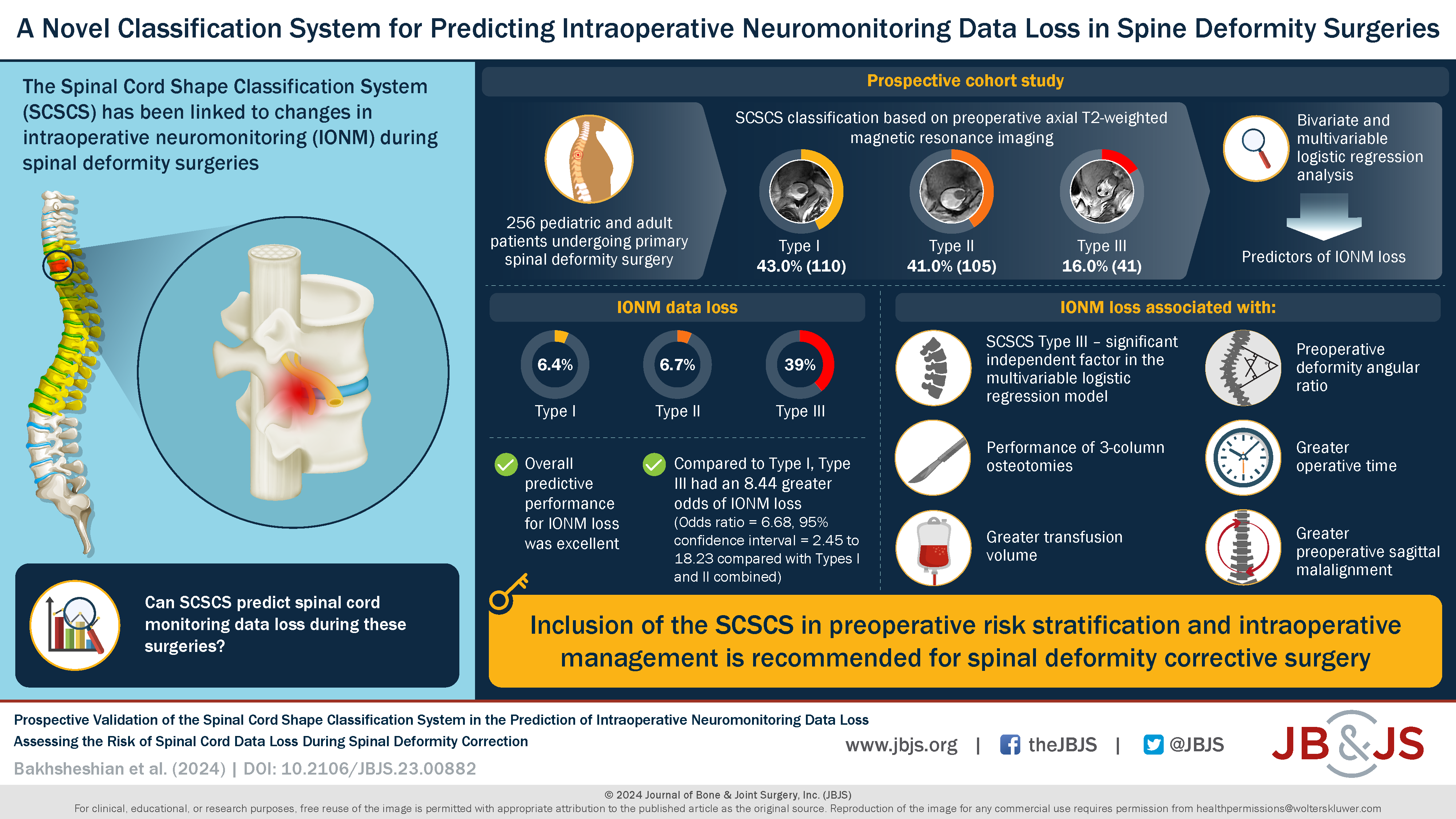In a study now published in JBJS, Bakhsheshian et al. sought to prospectively validate use of the Spinal Cord Shape Classification System (SCSCS) to identify patients at greater risk of spinal cord monitoring data loss during spinal deformity surgery. Adult and pediatric patients undergoing primary spinal deformity surgery were included in this prospective cohort study.
Access the study and the downloadable infographic at JBJS.org:
The authors point out that neurological deficits from spinal cord dysfunction are “a feared complication in spinal deformity surgery”1,2, with a number of potential causes of spinal cord dysfunction during surgery. They write that “the use of multimodal intraoperative neuromonitoring (IONM) is an essential adjunct in spinal deformity correction, allowing earlier detection of potential spinal cord dysfunction and intervention to reverse it”2,3,4. However, IONM data loss can occur tied to select patient and surgical risk factors.
SCSCS class was previously associated with IONM changes during spinal deformity surgery. In the current study, spinal cord morphology at the apex of the major curve was assessed on preoperative axial T2-weighted MRI scans. The investigators categorized patients into 3 spinal cord shapes using the SCSCS. Patients with and without IONM loss were compared in terms of demographics and surgical and radiographic variables, and predictors of IONM loss were determined.
Download the infographic for a summary of the findings. On multivariable analyses, SCSCS type was the strongest independent predictor of IONM loss. Patients with a Type-III spinal cord shape had greater odds of IONM loss vs. Types I and II.
As concluded by the investigators, “We recommend inclusion of the SCSCS as an important criterion for neurologic risk-stratification and management of spinal deformity correction in the spinal cord region after appropriate reliability testing has been completed and published.”
Read the study at JBJS.org: Prospective Validation of the Spinal Cord Shape Classification System in the Prediction of Intraoperative Neuromonitoring Data Loss: Assessing the Risk of Spinal Cord Data Loss During Spinal Deformity Correction
For more spine-related content, including videos of procedures, video abstracts, and infographics, go to JBJS Media on JBJS.org.
References
- Lenke LG, Fehlings MG, Shaffrey CI, Cheung KM, Carreon L, Dekutoski MB, Schwab FJ, Boachie-Adjei O, Kebaish KM, Ames CP, Qiu Y, Matsuyama Y, Dahl BT, Mehdian H, Pellisé-Urquiza F, Lewis SJ, Berven SH. Neurologic Outcomes of Complex Adult Spinal Deformity Surgery: Results of the Prospective, Multicenter Scoli-RISK-1 Study. Spine (Phila Pa 1976). 2016 Feb;41(3):204-12.
- Huang ZF, Chen L, Yang JF, Deng YL, Sui WY, Yang JL. Multimodality Intraoperative Neuromonitoring in Severe Thoracic Deformity Posterior Vertebral Column Resection Correction. World Neurosurg. 2019 Jul;127:e416-26.
- Vitale MG, Moore DW, Matsumoto H, Emerson RG, Booker WA, Gomez JA, Gallo EJ, Hyman JE, Roye DP Jr. Risk factors for spinal cord injury during surgery for spinal deformity. J Bone Joint Surg Am. 2010 Jan;92(1):64-71.J Bone Joint Surg Am
- Samdani AF, Bennett JT, Ames RJ, Asghar JK, Orlando G, Pahys JM, Yaszay B, Miyanji F, Lonner BS, Lehman RA Jr, Newton PO, Cahill PJ, Betz RR. Reversible Intraoperative Neurophysiologic Monitoring Alerts in Patients Undergoing Arthrodesis for Adolescent Idiopathic Scoliosis: What Are the Outcomes of Surgery?J Bone Joint Surg Am. 2016 Sep 7;98(17):1478-83.



